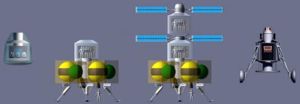
Home - Search - Browse - Alphabetic Index: 0- 1- 2- 3- 4- 5- 6- 7- 8- 9
A- B- C- D- E- F- G- H- I- J- K- L- M- N- O- P- Q- R- S- T- U- V- W- X- Y- Z
CEV SAIC
 CEV SAIC Credit: © Mark Wade |
Status: Study 2012. Gross mass: 20,600 kg (45,400 lb). Unfuelled mass: 13,900 kg (30,600 lb). Height: 15.00 m (49.00 ft). Diameter: 4.40 m (14.40 ft).
SAIC developed a baseline lunar exploration scenario of assembly of modules in low-earth orbit that were launched by EELV-derived launch vehicles made up of three, five, or seven EELV booster modules according to payload requirements. The assembled spacecraft would join up in lunar orbit, with the CEV remaining in lunar orbit while the lunar lander took the crew to the surface base and back. In its CEV study SAIC went through a rigorous series of iterations to identify economies throughout a lunar base infrastructure through use of common subsystems and modules. In the final iteration, the CEV itself was a notional design, a Soyuz-shaped four-crew re-entry vehicle using the common pressure vessel with a mass of 10.4 metric tons. The CEV's Service Module would have a dry mass of 3.5 metric tons and use an RL10 Lox/LH2 engine. This would be used only for the trans-earth injection maneuver back from lunar orbit.
The final SAIC mission sequence was spread over 18 years and would require 76 launches of EELV-derived vehicles using 334 EELV common-core stages. A common pressure module design would be used in the cargo module, the two-module lunar surface habitat, and lunar module, and the CEV crew capsule. Liquid oxygen/liquid hydrogen and RL10 engines would be used in all propulsion units (SAIC considered storable propellants and liquid oxygen/methane, but rejected the less-efficient propellants for driving up total mission mass requirements). The mission sequence was as follows:
SAIC, at NASA's urging, considered an alternative scenario with use of Shuttle-derived heavy-lift vehicles, which reduced the number of launches required from 76 to 63, but nearly double the cost and would, SAIC said, "undermine the American commercial launch market".
Crew Size: 4.
Family: Lunar Bases, Manned spacecraft, Moon. Country: USA. Engines: RL-10. Propellants: Lox/LH2. Agency: NASA, SAIC.
 | CEV SAIC Credit: NASA |
Back to top of page
Home - Search - Browse - Alphabetic Index: 0- 1- 2- 3- 4- 5- 6- 7- 8- 9
A- B- C- D- E- F- G- H- I- J- K- L- M- N- O- P- Q- R- S- T- U- V- W- X- Y- Z
© 1997-2019 Mark Wade - Contact
© / Conditions for Use